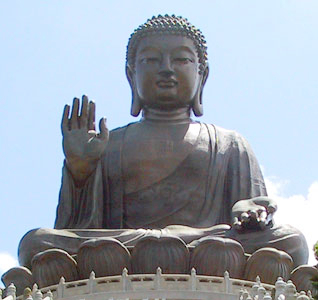Page Summary
In the sixth century BCE, in ancient India, Siddhartha Gautama, also called the Buddha (meaning "the awakened one"), created Buddhism. Buddhism does not have a specific deity that is worshipped, and rather focuses on achieving spiritual peace in yourself and understanding life. Buddhists believe that there is no difference between one human and another. Buddhists hold that rebirth, also known as reincarnation, is a notion in which one experiences birth, death, and rebirth repeatedly until they reach enlightenment and are able to break free from the cycle.
There are 470 million practicing Buddhist followers in the world today.


For more on world religions, cross link to
Buddhism
Buddhism began in Nepal around 2,500 years ago, when Siddhartha Gautama became the first Enlightened and began to spread the word of Buddhism.
Buddhism does not have a specific deity that is worshiped, and rather focuses on achieving spiritual peace in yourself and understanding life. Buddhists believe that there is no difference between one human or another.
Buddhism places a strong emphasis on meditation as a means of developing insight, awareness, and focus. To cultivate spiritual insight, emotional equilibrium, and mental clarity, a variety of meditation practices are employed.
Buddhists hold that by engaging in meditation and developing a lifestyle that the Buddha advised, people can potentially be set free from suffering. Before his death, the Buddha delivered numerous discourses. His doctrines are called the Dharma.
Given that it represents the cycle of life and death, the wheel is a highly significant symbol in Buddhism. Buddhists hold that after passing away, souls reincarnate, or take on a new shape. This new form could be that of a human, animal, deity, or other lesser being.
The Buddha preaches his First Sermon about the Four Noble Truths to the Group of Five Monks

The Four Noble Truths
To learn more about Buddhism's specific origins
To learn more about Buddhism and how it is practiced
To learn more about buddhism's origins, teachings, early developments, conflict and new groupings, and expansion Philosophy of Religion: Buddhism
A brief history of Buddhism from Khan Academy

To see a video of a brief overview of Buddhism
To see a video describing Buddhist practices and culture
To see a video by Crash Course comparing Buddhism and Hinduism
To see a lesson plan entitled "Teaching With 'The Buddha'"
Buddhism and its Spread
Buddhism began to spread out from Nepal into neighboring countries across Asia, including China, Korea, and Vietnam. It took a few centuries to achieve this and ultimately made Buddhism a global faith with a large following.

As time progressed, Buddhism was slowly changed across cultures and became less specific as to which methods were practiced, and many regions have different specific
practices local to their respective areas. Many Buddhist practices were adopted into the Hindu faith and remain practiced to this day. There remain about 350 million practicing Buddhist followers today.
A timeline detailing the origin and spread of Buddhism
See the map below to see how quickly Buddhism spread
Women in Buddhism
Women have a complex, and varied relationship with Buddhism. Because Buddhism is so vast, and widely participated in, Buddhist traditions and cultures can vary greatly, so it would be unfair to generalize women's roles. With that being said, ancient Buddhist texts are often disparaging towards women, claiming that they can never become enlightened, or that they will become men as they approach enlightenment.
For further reading regarding the relationship between Buddhism and women
Teaching Resources
Click Here for a textbook on World History until 1500 that goes in depth on Buddhism's origins and the noble truths of Buddhism.
Click Here for a guided Buddhist mediation video.
Comments (0)
You don't have permission to comment on this page.